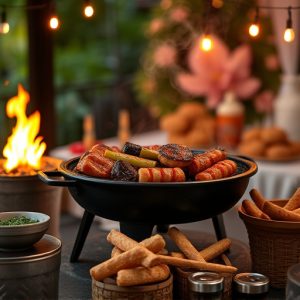Selecting the right cut of ribs (baby back or spare) and seasoning them with a well-balanced dry rub is key to grilling perfect BBQ ribs. Cooking at low and slow temperatures (225°F – 250°F) using indirect heat and wood chips/chunks ensures even cooking, transforming tough collagen into gelatinous meat. Regular basting with BBQ sauce adds moisture and flavor without burning. Patience and proper technique result in melt-in-your-mouth ribs that are the essence of a successful BBQ rib recipe.
Unleash your inner grill master with our ultimate guide to crafting the perfect barbecue ribs. From selecting the ideal cut of ribs to mastering the art of seasoning and grilling, we’ve got you covered. Learn the science behind achieving tender, fall-off-the-bone ribs through dry heat and moisture. Discover techniques to smoke and grill like a pro, ensuring every bite is a symphony of smoky flavor. Whether you’re a seasoned BBQ enthusiast or just starting, this guide offers valuable tips for creating a mouthwatering BBQ rib recipe that will have your folks licking their bones clean.
- Choosing the Right Ribs: Selecting the Perfect Cut for BBQ Bliss
- Seasoning 101: The Art of Rubbing Your Ribs to Flavorful Perfection
- Mastering the Grill: Techniques for Smoking and Grilling Ribs Like a Pro
- The Science of Cooking Ribs: Understanding Dry Heat and Moisture for Tender Results
- Slow and Steady Wins the Race: Patience is Key in Creating Fall-Off-the-Bone Ribs
Choosing the Right Ribs: Selecting the Perfect Cut for BBQ Bliss
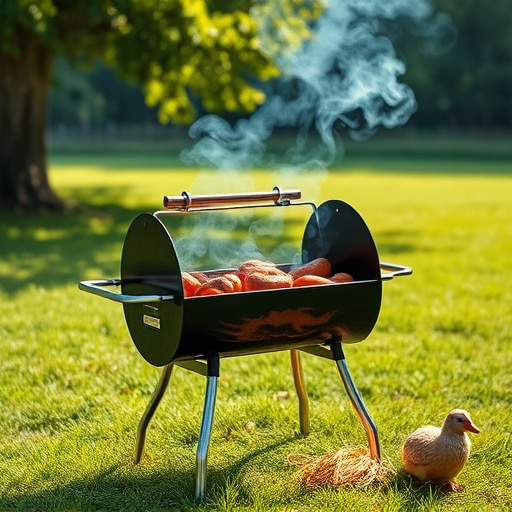
When it comes to achieving barbecue perfection, selecting the right ribs is half the battle won. The key lies in understanding the various cuts available and choosing one that aligns with your grilling style and desired outcome. For a classic BBQ rib recipe, opt for baby back ribs or spare ribs. Baby back ribs, as the name suggests, come from the top of the rib cage and are known for their tender meat and meaty bone structure, making them ideal for slow-cooking methods like smoking. On the other hand, spare ribs, with their larger size and more bones, offer a hearty, robust flavor that pairs well with direct heat grilling techniques.
The perfect cut ensures that your ribs cook evenly, resulting in tender meat that glistens with juicy goodness. Remember, the quality of your BBQ rib recipe hinges on selecting the right starting point for your culinary journey. So, whether you’re a connoisseur of baby back ribs or prefer the challenge of spare ribs, choosing the right cut is a crucial step towards creating a mouthwatering BBQ rib experience that will have your taste buds dancing with delight.
Seasoning 101: The Art of Rubbing Your Ribs to Flavorful Perfection
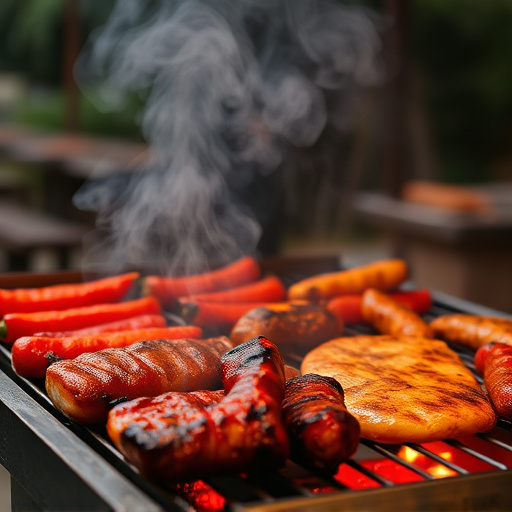
Seasoning is a key step in achieving perfect barbecue ribs. The “rub”—a mixture of spices—is more than just salt and pepper; it’s an art form that can transform your ribs from ordinary to extraordinary. Think of it as painting your meat with flavors, allowing each spice to penetrate and infuse its unique taste. A good rub blend should include a combination of dry heat spices like paprika, cayenne pepper, garlic powder, and onions powder for a savory base, balanced with sweetness from brown sugar or molasses. Adjust the heat level based on your preference—a lighter touch for a subtle kick or a more robust blend for fiery heat.
Apply the rub generously to both sides of your ribs, massaging it into the meat so it sticks and creates a delicious crust as they grill. Letting the ribs come to room temperature before grilling allows the spices to really adhere, ensuring a flavorful result. Don’t be afraid to experiment with different rubs; BBQ rib recipes are incredibly versatile, allowing you to tailor them to your taste.
Mastering the Grill: Techniques for Smoking and Grilling Ribs Like a Pro
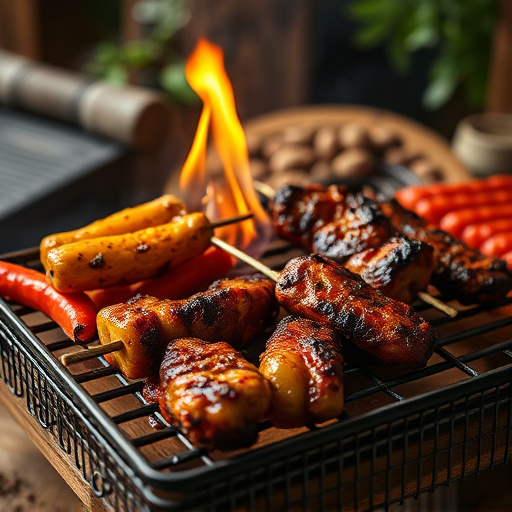
Mastering the art of grilling and smoking BBQ ribs is a skill every serious grill master should aspire to. It’s a process that combines patience, precise temperature control, and a deep understanding of meat science. To achieve perfect ribs, whether you’re using a charcoal or gas grill, start by preparing your ribs properly. This involves scoring the membrane on the bone side to break down connective tissues and applying a dry rub of spices to infuse flavor.
Next, for smoking, set up your grill for indirect heat, allowing for slow, even cooking. Maintain a consistent temperature between 225°F – 250°F (107°C – 121°C) using wood chips or chunks for added smoke flavor. This low-and-slow method ensures the ribs cook evenly, rendering the collagen in the meat into gelatin, resulting in tender, suckling ribs. Regularly baste with your favorite BBQ sauce to add moisture and enhance the smoky, delicious taste—just be careful not to burn it!
The Science of Cooking Ribs: Understanding Dry Heat and Moisture for Tender Results
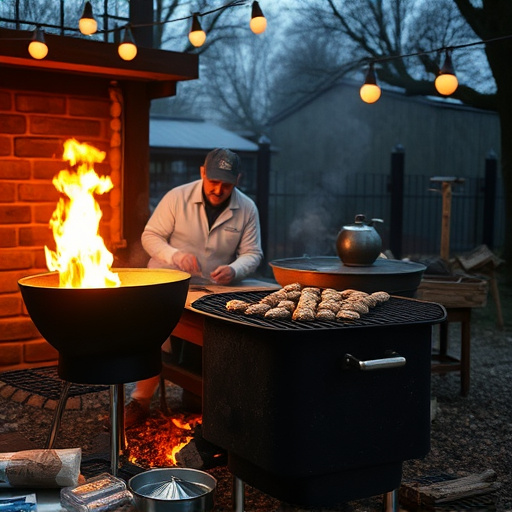
Cooking barbecue ribs is a science that blends precise techniques with a deep understanding of heat and moisture. The key to achieving tender, mouthwatering ribs lies in managing these elements effectively. When grilling BBQ rib recipes, applying dry heat—in this case, direct flame or hot coals—plays a crucial role in sealing in the meat’s natural juices and developing a delicious crust. This initial step helps to caramelize sugars on the surface of the ribs, enhancing their flavor profile.
However, the real magic happens as the cooking process progresses. Moisture, either from marination or added during cooking (like basting), keeps the ribs juicy and prevents them from drying out. The science behind this is that moisture helps to break down collagen in the meat, transforming it into gelatin. This transformation not only makes the ribs more tender but also contributes to that delectable, melt-in-your-mouth texture that grillers strive for.
Slow and Steady Wins the Race: Patience is Key in Creating Fall-Off-the-Bone Ribs
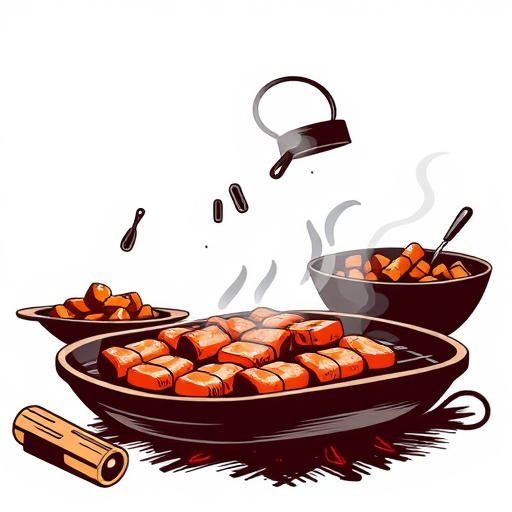
Grilling perfect barbecue ribs is an art that requires time, patience, and a calm approach. Many beginners make the mistake of rushing the process, but in reality, slow and steady cooking is what transforms tough rib meat into melt-in-your-mouth goodness. The key to success lies in understanding that low and slow cooking allows the collagen in the ribs to break down, resulting in tender, succulent meat.
When grilling BBQ ribs, maintaining a consistent low temperature is essential. This method slowly cooks the ribs, ensuring the meat becomes incredibly tender. Avoid high heat, as it can dry out the ribs before they cook through. Instead, use indirect heat and keep the grill cover on to create a humid environment, which helps to break down the connective tissues, making your ribs fall off the bone with every delicious bite of your BBQ rib recipe.
